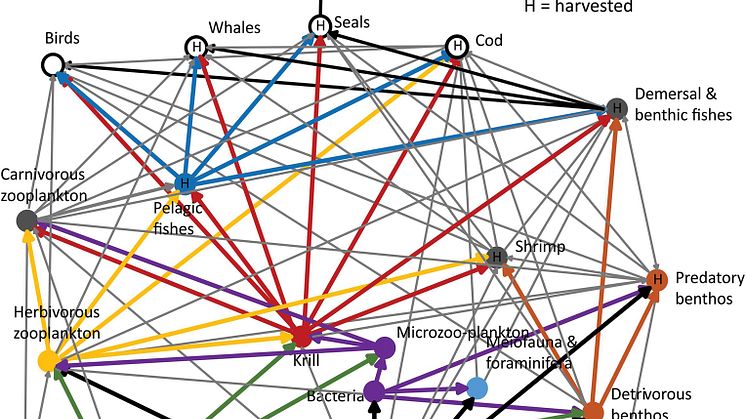
Nyhet -
Overexploitation, recovery, and warming of the Barents Sea ecosystem during 1950–2013
The Barents Sea is a high-latitude shelf ecosystem with important fisheries, high and historically variable harvesting pressure, and ongoing high variability in climatic conditions.
To quantify carbon flow pathways and assess if changes in harvesting intensity and climate variability have affected the Barents Sea ecosystem. A team has modelled the ecosystem for the period 1950–2013 using a highly trophically resolved mass-balanced food web model (Ecopath with Ecosim). The results were recently published in an article in Frontiers in Marine Science with Torstein Pedersen from UiT the Arctic University of Norway as the first author: https://www.frontiersin.org/ar...
Ecosim models were fitted to time series of biomasses and catches, and were forced by environmental variables and fisheries mortality. The effects on ecosystem dynamics by the drivers fishing mortality, primary production proxies related to open-water area and capelin-larvae mortality proxy, were evaluated.
During the period 1970–1990, the ecosystem was in a phase of overexploitation with low top-predators’ biomasses and some trophic cascade effects and increases in prey stocks. Despite heavy exploitation of some groups, the basic ecosystem structure seems to have been preserved.
After 1990, when the harvesting pressure was relaxed, most exploited boreal groups recovered with increased biomass, well-captured by the fitted Ecosim model. These biomass increases were likely driven by an increase in primary production resulting from warming and a decrease in ice-coverage.
During the warm period that started about 1995, some unexploited Arctic groups decreased whereas krill and jellyfish groups increased. Only the latter trend was successfully predicted by the Ecosim model. The krill flow pathway was identified as especially important as it supplied both medium and high trophic level compartments, and this pathway became even more important after ca. 2000.
The modelling results revealed complex interplay between fishery and variability of lower trophic level groups that differs between the boreal and arctic functional groups and has importance for ecosystem management.
The study was funded by Norway-Canada collaborative project “A Transatlantic innovation area for sustainable development in the Arctic” (CoArc) (Project Number 8048 at Akvaplan-Niva and QZ-15/0457 at Norwegian Ministry of Foreign Affairs). The Research Council of Norway also provided partial support through the project “The Nansen Legacy” (RCN#276730).
